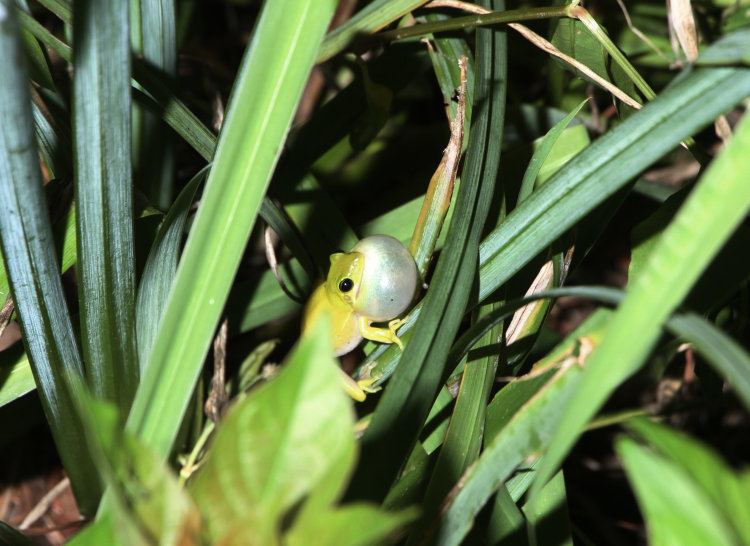
No, I’m not trying to show off my amateur naturalist cred, and no, ‘amateur naturalist’ doesn’t mean I’m bad at getting nekkid – that’s ‘naturist,’ goober. And you still wouldn’t want to see it.
No, I’m referring to the fact that all of these were shot while I was looking for snakes for World Snake Day, which is still going on as I type this and might, just might, see some late entries. I was just seeing a lot more than snakes, like, the green treefrogs (Dryophytes cinereus) were remarkably active last night, possibly because it had cooled down a little more than it had been. This did not make it ‘cool’ – I was still covered in sweat from the session without any physical exertion and only a tiny bit of stress, but we’ll get to that.
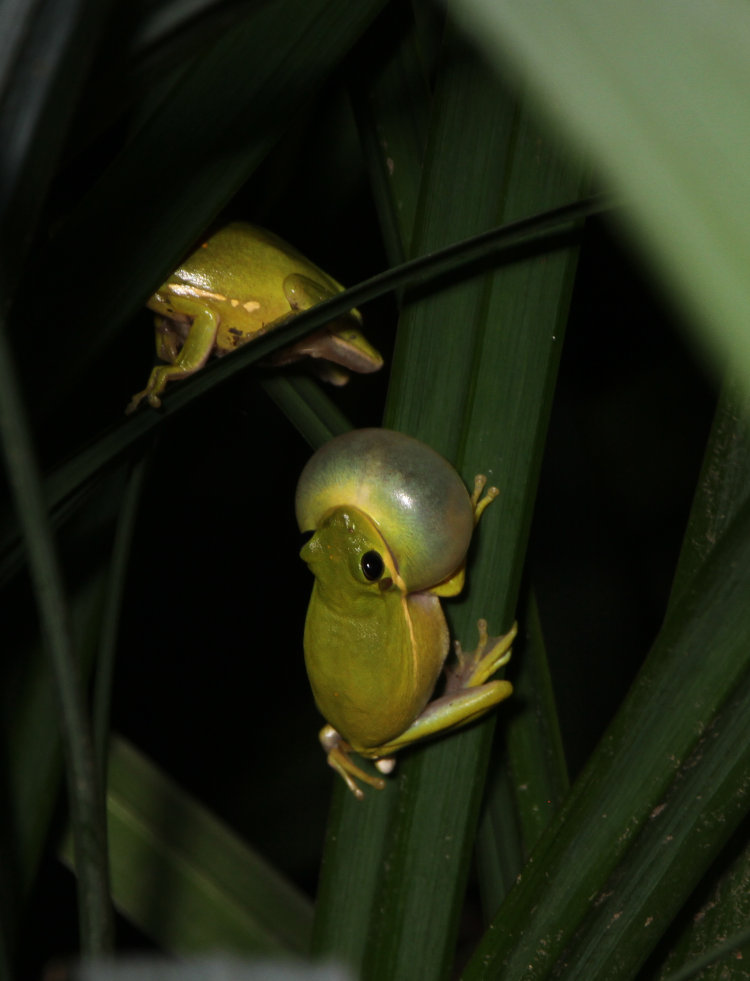
None of the snakes that I saw were anywhere near the spots where the frogs were, which suggests that snakes would do better if they could hear, because these guys were hard to miss. But hearing takes place in most animals through the repurposing of jawbones from our ancient reptilian ancestors, the same bones that snakes kept in their jaws to allow them to swallow prey much bigger than their head. Now, snakes are pretty sensitive to vibrations felt through the ground (or anything else they’re sitting on,) and I spooked one of my potential subjects by carelessly trodding softly on a pinecone that was over a meter off – the snake’s immediate reaction would’ve convinced you that they could hear. But a day of heavy rains wasn’t enough to counteract six weeks or more of scalding sun, and so the earth remains dry and packed and may well have carried the vibrations better. Or the pinecone was wired into the snake’s vibrating cellphone. Meanwhile, I wonder if frogs have developed calls in a frequency that doesn’t elicit many vibrations where snakes can sense them, because they certainly were louder than the noise from the pinecone.
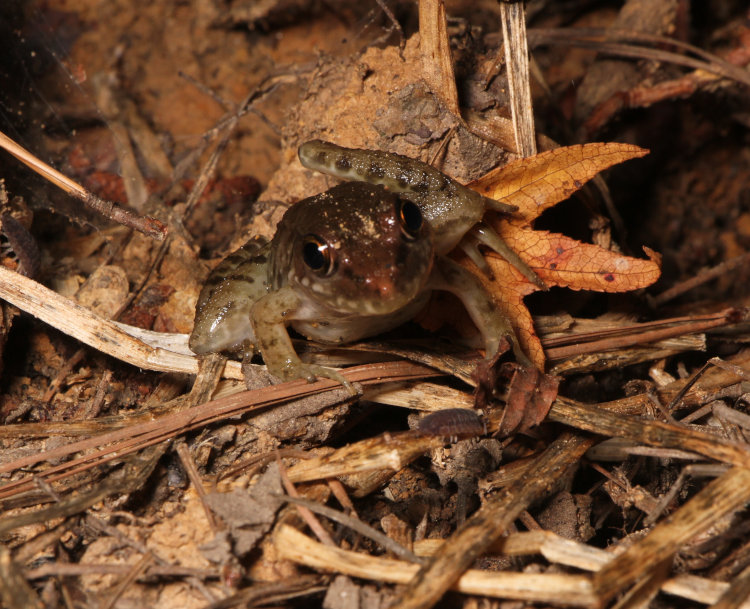
This was one of several other species out last night, a green frog (Lithobates clamitans,) a larger and aquatic frog, though this specimen was only fractionally bigger than the treefrogs. These were calling too, as were American bullfrogs, eastern narrowmouth toads, and some ‘ratcheting’ bugger that I didn’t recognize by sound and couldn’t get a peek at. Yep, one big singles bar of attempted procreation, and me voyeuring in the middle of it.
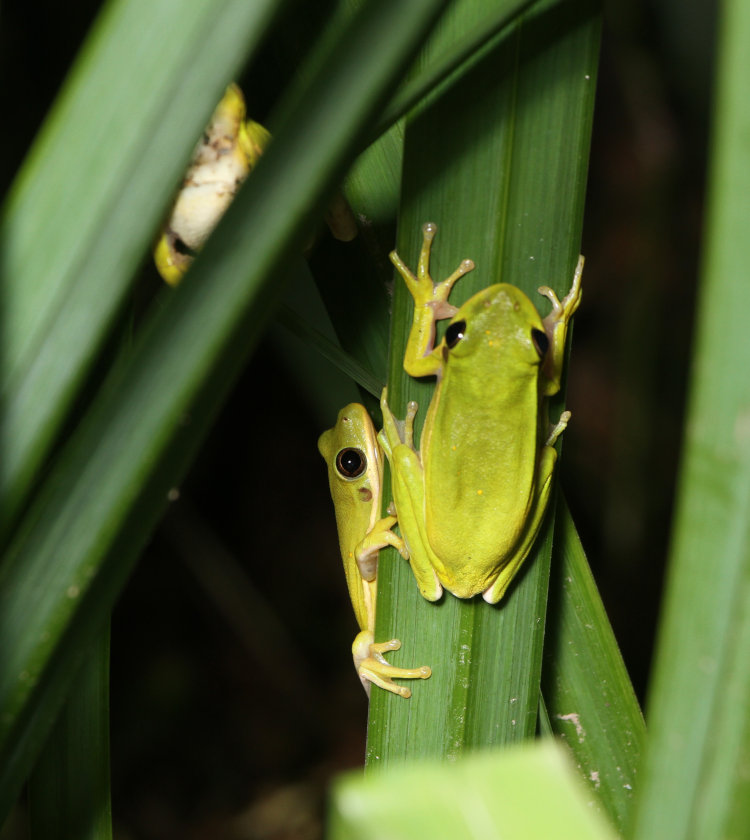
I think these were the same frogs and reeds seen above, now on my return pass, and I’m pretty sure another was calling just out of sight behind these reeds, suggesting that these were all ardent males. I’d sit and video the process but I’m not sure that I’d see much, because the light of the headlamp (and by extension the video light) makes them nervous and tend to stop calling. Plus in reeds like this, it’s easy to get a bad light angle and throw shadows, which makes them even more nervous because something blocking out the sun is often an indication of danger looming.
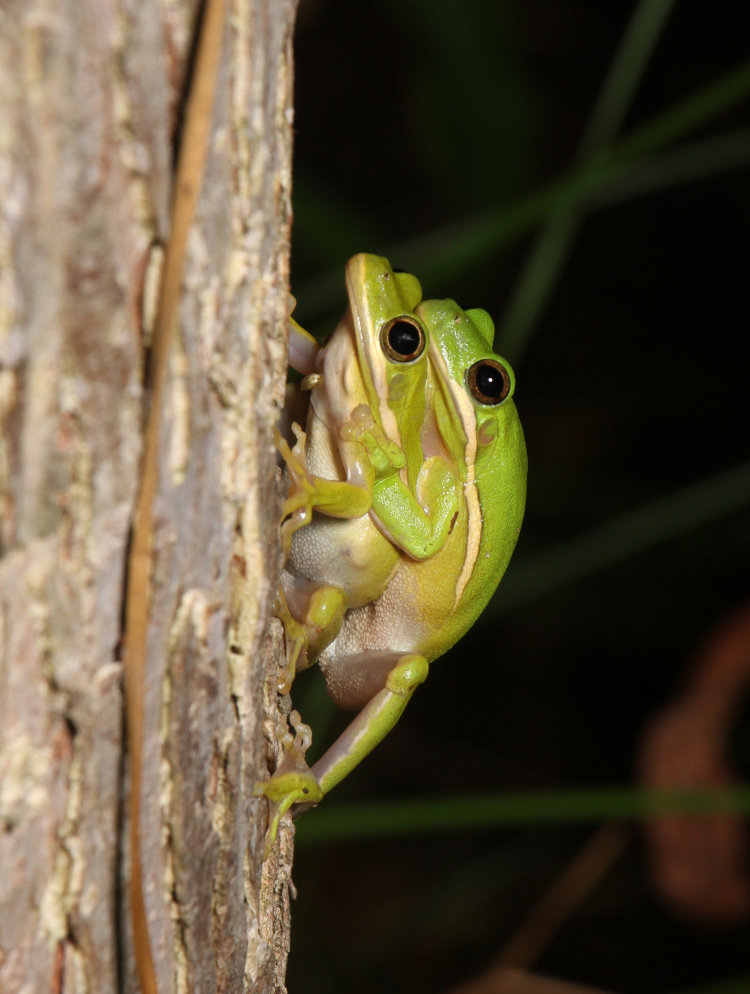
However, I did at least find a pair that had almost sealed the deal, yet still sitting complacently on a trunk instead of heading down to the water to lay and fertilize some eggs. I’ve seen this plenty of times – there is often a period of just sitting there, and I don’t know why this is – possibly that ‘small talk‘ thing I keep hearing about.
By the way, if you noticed that the female’s eye doesn’t have the distinct reflection of the male’s, this was even visible in the headlamp while I was focusing, and is potentially a damaged cornea.
There were more than frogs out too. Like spiders.

There were scads of fishing spiders all over the place, skating out across the water, but all of those that I could see clearly were smaller examples of the six-spotted fishing spider. This, however, was many times their size, curiously standing ‘tiptoe’ on a log out in the water, so I couldn’t get closer. It’s likely a Dolomedes tenebrosus, the largest species of fishing spider in this area, whose leg spread can cover your palm. Why it’s sitting like this I can’t say, but it does remind me of how I stand sometimes when it’s too hot and those sweaty areas are getting annoying.
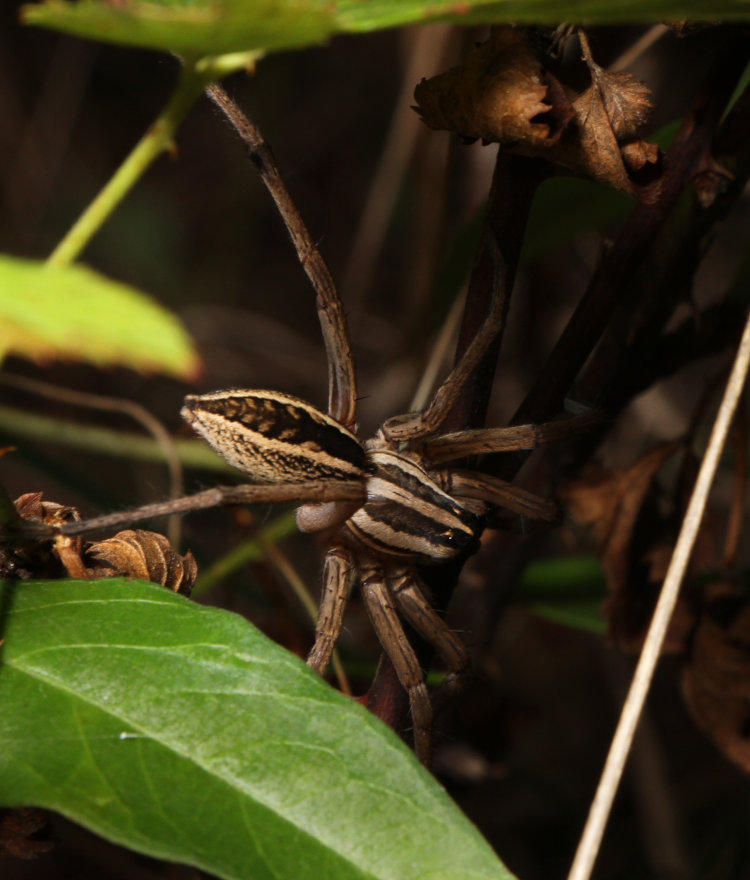
According to a quick search just now, this would appear to be a rabid wolf spider (Rabidosa rabida) – the markings fit the description and the photos. What got my attention were brilliant and largish reflections from the eyes; I’d been seeing such all night, because both wolf and fishing spider eyes reflect vividly and they were all over the place, but these were brighter and more distinctive than I’d seen before and I went in for a closer look. She didn’t want to come out in the open and this was as good as I could coax her to pose, but she almost got a free meal from me because the moths were attracted to the headlamp and they kept blundering into her eyrie – she made a couple of failed attempts to catch them as I watched.
The other was a lot more cooperative, however.
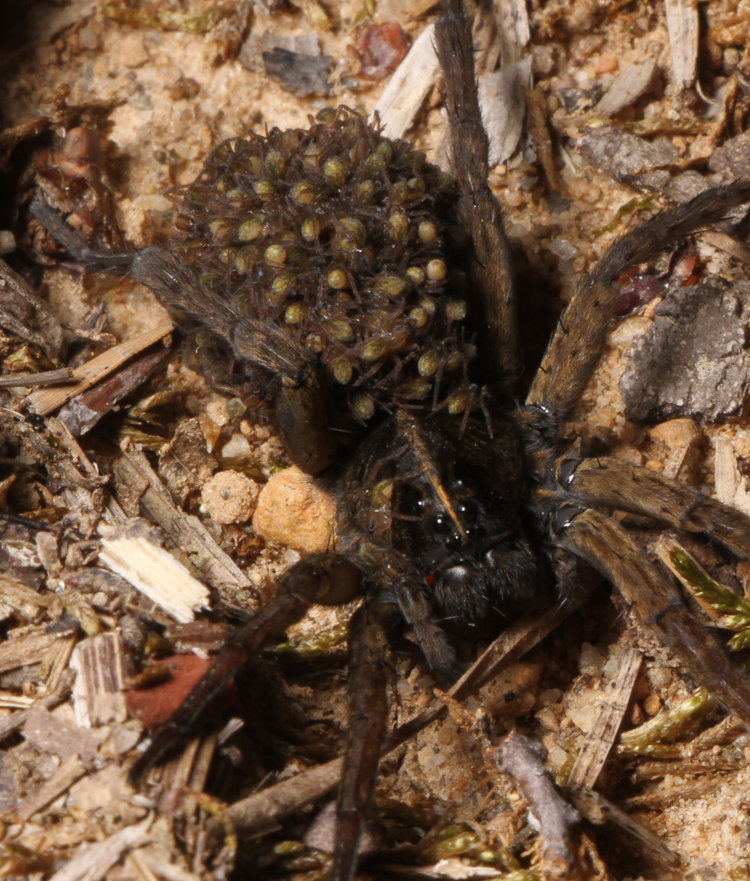
This one was large enough and dark enough to be found without any help from reflections, which was a shame because there should have been a lot of them. Too few markings visible to try to identify, plus the fact that many wolf spiders (Family Lycosidae) are difficult to distinguish anyway, but it’s clearly a mama wolf spider with bebbies. Note the rearmost row of eyes, the position of which distinguishes this from fishing spiders, where they would be more in a row with the two largest eyes. And of course a few bebbies moving forward onto her cephalothoraz. She paused and held still nicely for several close frames, and even allowed me to sneak my finger into the frame on the smutphone for a scale shot to freak out friends – in leg spread she was probably close to 60mm.
And even more – not spiders, but we’re also not reducing the leg count.
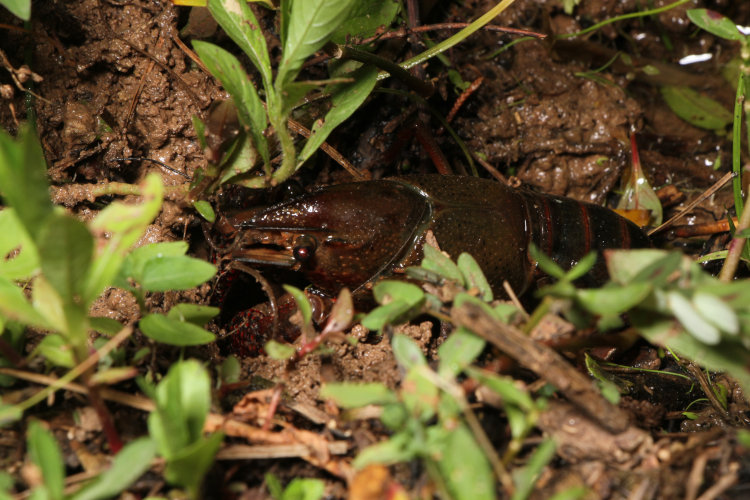
I’ve seen these from time to time, most often after a heavy rain which tends to bring them out onto land. I believe this is a red swamp crayfish (Procambarus clarkii,) quite large as far as crayfish go, not just rivaling shrimp, but they also used to form the bulk of the crayfish served as food – this one was over 100mm in length, snout to tail, and much thicker than my thumb.
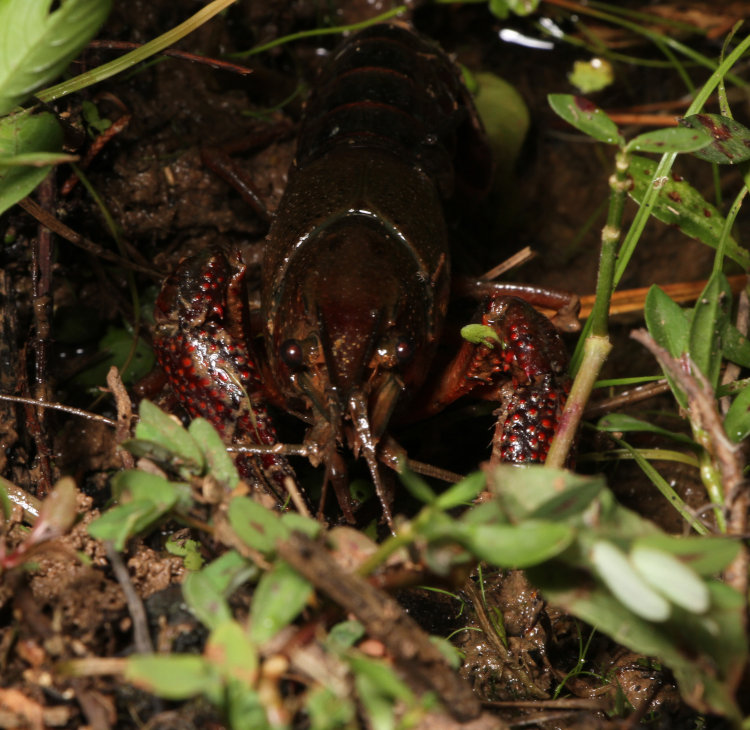
Those larger chelae (pincers) indicate this is a male, and it was foraging enthusiastically in the mud at the water’s edge, almost wholly exposed from the water. Those eyes were producing red internal reflections which showed up well in the headlamp, only vaguely visible here (the flash was offset a bit.) Eventually, I did an incautious move that alerted the crayfish somehow, because after several frames and a little maneuvering from me for a better view, he decided to hurriedly slip back into the water.
And finally,
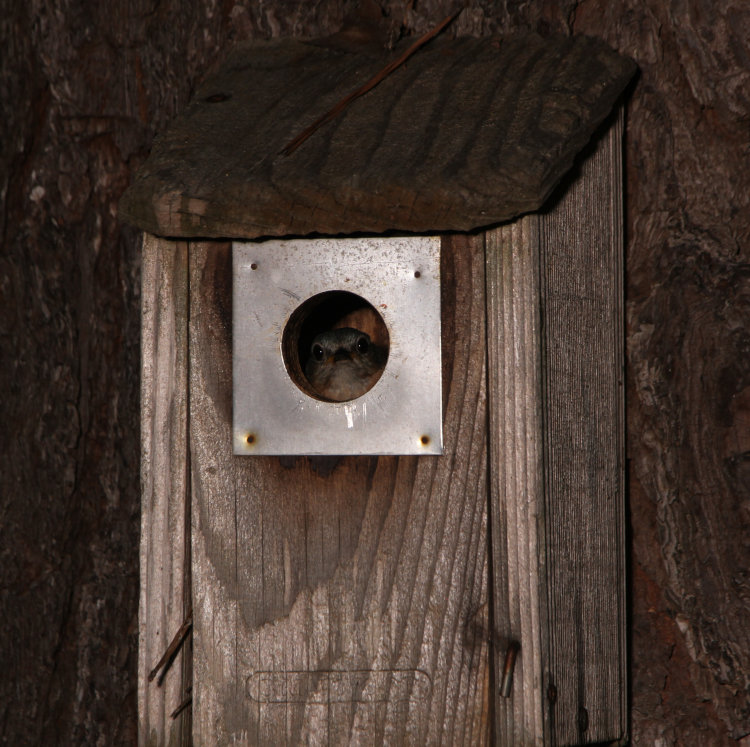
Remember what I said about stress? One of the bluebird boxes along the pond was occupied again, the second brood for the year (quite common around here,) and the female eastern bluebird (Sialia sialis) was just watching me, unblinking, unmoving – it was seriously creeping me out. What? I’m just looking for snakes, I don’t give a shit about your eggs – go glare at someone else.



















































